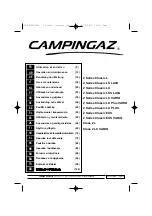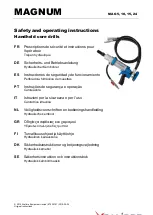
English |
15
standardised measuring procedure and may be used to com-
pare power tools. They may also be used for a preliminary
estimation of vibration and noise emissions.
The stated vibration level and noise emission value repres-
ent the main applications of the power tool. However, if the
power tool is used for other applications, with different ap-
plication tools or is poorly maintained, the vibration level
and noise emission value may differ. This may significantly
increase the vibration and noise emissions over the total
working period.
To estimate vibration and noise emissions accurately, the
times when the tool is switched off or when it is running but
not actually being used should also be taken into account.
This may significantly reduce vibration and noise emissions
over the total working period.
Implement additional safety measures to protect the oper-
ator from the effects of vibration, such as servicing the
power tool and application tools, keeping their hands warm,
and organising workflows correctly.
Assembly
u
Remove the battery from the power tool before carry-
ing out work on the power tool (e.g. maintenance,
changing tool, etc.). The battery should also be re-
moved for transport and storage.
There is risk of injury
from unintentionally pressing the on/off switch.
Battery Charging
u
Use only the chargers listed in the technical data.
Only
these chargers are matched to the lithium-ion battery of
your power tool.
Note:
The battery is supplied partially charged. To ensure
full battery capacity, fully charge the battery in the charger
before using your power tool for the first time.
The lithium-ion battery can be charged at any time without
reducing its service life. Interrupting the charging process
does not damage the battery.
The lithium-ion battery is protected against deep discharge
by the "Electronic Cell Protection (ECP)". When the battery
is discharged, the power tool is switched off by means of a
protective circuit: The application tool no longer rotates.
u
Do not continue to press the On/Off switch after the
power tool has automatically switched off.
The battery
can be damaged.
Follow the instructions on correct disposal.
Bosch
recommends using battery
packs with a capacity of at least 3.0
Ah.
Inserting and removing the battery (see figures
A1–A2)
u
Do not use force to insert the battery.
The battery is de-
signed in such a way that it can only be inserted into the
power tool when it is in the right position.
– Slide the battery
(11)
all the way into the battery bay.
– To remove the battery
(11)
, press the release but-
ton
(13)
on the battery and pull it out of the battery bay.
Battery Charge Indicator
The green LEDs on the battery charge indicator
(17)
indic-
ate the state of charge of the battery
(11)
. For safety reas-
ons, it is only possible to check the state of charge when the
power tool is not in operation.
Press the battery charge indicator button
(16)
to show the
state of charge. This is also possible when the battery is re-
moved.
If no LED lights up after pressing the battery charge indicator
button
(16)
, the battery is defective and must be replaced.
Battery model GBA 18V… (see figure B1)
LEDs
Capacity
3× continuous green light
60−100 %
2× continuous green light
30−60 %
1× continuous green light
5−30 %
3× flashing green light
0−5 %
Battery model ProCORE18V… (see figure B2)
LEDs
Capacity
5× continuous green light
80−100 %
4× continuous green light
60−80 %
3× continuous green light
40−60 %
2× continuous green light
20−40 %
1× continuous green light
5−20 %
1× flashing green light
0−5 %
Swivelling the auxiliary handle (see figure C)
You can swivel the auxiliary handle
(14)
to any angle for a
safe work posture that minimises fatigue.
– Turn the lower gripping end of the auxiliary handle
(14)
anticlockwise and swivel the auxiliary handle
(14)
into
the required position. Then turn the lower gripping end of
the auxiliary handle
(14)
clockwise to retighten it.
Make sure that the retaining strap of the auxiliary handle
slots into the corresponding groove of the housing.
Changing the Tool
u
Replace a damaged dust protection cap immediately.
It is recommended that you have use an after-sales
service for this.
The dust protection cap
(3)
largely prevents the penetration
of drilling dust into the tool holder during operation. When
inserting the tool, make sure that the dust protection cap
(3)
does not become damaged.
Inserting SDS-plus application tools (see figure D1)
As a requirement of the system, the SDS-plus application
tool can move freely. This causes a certain radial run-out at
no-load, which has no effect on the accuracy of the drill hole,
as the drill bit centres itself upon drilling.
Bosch Power Tools
1 609 92A 5B9 | (07.02.2020)
Содержание Professional GBH 180-LI
Страница 3: ... 3 2 3 4 5 6 7 1 8 9 10 11 12 13 14 15 10 14 Bosch Power Tools 1 609 92A 5B9 07 02 2020 ...
Страница 4: ...4 A1 A2 B1 C D1 D2 11 13 14 4 B2 17 16 16 17 1 609 92A 5B9 07 02 2020 Bosch Power Tools ...
Страница 5: ... 5 X E F G 8 2 15 5 18 Bosch Power Tools 1 609 92A 5B9 07 02 2020 ...
Страница 214: ...214 1 609 92A 5B9 07 02 2020 Bosch Power Tools ...
















































